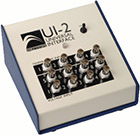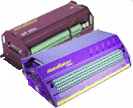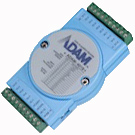Connecting A-D converters
On modern Macs, which have USB ports, you need a USB --> serial converter for all of these devices except the Sable UI3. I've verified that the Keyspan (now, TrippLite) USA-19HS works nicely. I've also verified that other converters DO NOT work reliably, so I highly recommend the Keyspan/Tripp Lite units. Make sure the driver software is appropriate for whatever version of macOS you are running. Here are some connection considerations for the various supported A-D converters (more details on these devices are here).
 Sable Systems Universal Interface 'UI2' or 'UI3':
Sable Systems Universal Interface 'UI2' or 'UI3':
Connecting the UI2 is simple. With your USB-serial converter installed (with the necessary driver software), you should not have to do anything except plug in the cable that comes with the UI2.
Connecting the UI3 is usually even simpler. No USB-serial converter is needed. You may need to install FTDI software drivers (not necessary on late versions of MacOS) but after that you should not have to do anything except plug in the USB cable that comes with the UI3.
 Data Electronics DataTakers:
These instructions refer to the basic DT50/500/600 (referred to below as 'DT500') and DT800
models. Earlier models may not work, and I have not had the opportunity to test other versions. However, users have told me that other DataTaker models do work with the software. Data Electronics DataTakers:
These instructions refer to the basic DT50/500/600 (referred to below as 'DT500') and DT800
models. Earlier models may not work, and I have not had the opportunity to test other versions. However, users have told me that other DataTaker models do work with the software.
- The software expects the default factory settings (no parity, 8 data bits, 1 stop bit). For the DT500, the standard baud rate is 4800. For the DT800, a faster rate will be automatically used, up to 115,000 baud (if necessary, the maximum rate can be adjusted from within the LabHelper A-D menu). If you want
to use other baud rates on the DT500, set the appropriate DataTaker switches for the desired
rate. Make sure to use no parity, 8 data bits, and 1 stop bit (If
these settings are incorrect, the software won't work).
- Build (or purchase) a connecting cable and power supply, as outlined
in the very detailed and helpful DataTaker instruction manual.
- To drive external devices with a DataTaker's digital outputs, you may have to build a simple circuit to supply the necessary positive voltages.
|
 Advantech ADAM-4019:
The ADAM 4019 is a simple, inexpensive A to D converter. It has 8 quite versatile channels (each can be a voltage or thermocouple input). However, it isn't very fast (specified as about 10 samples/second total, but I've found it to be somewhat faster) and it has no digital or voltage outputs, so you can't control external devices with it (but you can get digital outputs by adding an ADAM 4050, and another 8 A-D channels by adding another ADAM 4019 or 4017). Advantech ADAM-4019:
The ADAM 4019 is a simple, inexpensive A to D converter. It has 8 quite versatile channels (each can be a voltage or thermocouple input). However, it isn't very fast (specified as about 10 samples/second total, but I've found it to be somewhat faster) and it has no digital or voltage outputs, so you can't control external devices with it (but you can get digital outputs by adding an ADAM 4050, and another 8 A-D channels by adding another ADAM 4019 or 4017).
- The software expects the default factory settings (no parity, 8 data bits, 1 stop bit). For the DT500, the standard baud rate is 9600. A faster rate will be automatically used, up to 115,000 baud (if necessary, the maximum rate can be adjusted from within the LabHelper A-D menu). Make sure to use no parity, 8 data bits, and 1 stop bit (If
these settings are incorrect, the software won't work).
- Build (or purchase) a connecting cable and power supply, as outlined
in the instruction manual. Note that the ADAM units use the RS-485 protocol, so you'll need an RS-232 to RS-485 converter to use it with the TrippLite USA-19HS.
- To drive external devices with a 4050's digital outputs, you may have to build a simple circuit to supply the necessary positive voltages.
| |